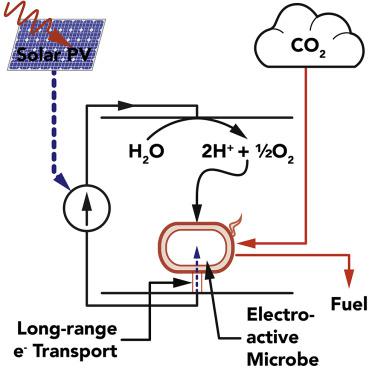Joule ( IF 39.8 ) Pub Date : 2020-09-23 , DOI: 10.1016/j.joule.2020.08.010 Farshid Salimijazi , Jaehwan Kim , Alexa M. Schmitz , Richard Grenville , Andrew Bocarsly , Buz Barstow

|
Electromicrobial production aims to combine electricity and microbial metabolism for solar and electrical energy storage. We have constructed molecule to reactor models of highly engineered electromicrobial production systems that use H2 oxidation and direct electron transfer (DET). We predict electrical-to-biofuel conversion efficiency could rise to 52% with engineered in vivo CO2 fixation. H2 diffusion at ambient pressure requires areas 20 to 2,000 times the solar photovoltaic (PV) area supplying the system. Agitation can reduce this below the PV area, and the power needed is negligible when storing ≥1.1 megawatts. DET systems can be built with areas ≤ 15 times the PV area and have low energy losses even with natural conductive biofilms and can be even smaller if the conductivity could be raised to match conductive artificial polymers. Schemes that use electrochemical CO2 reduction could achieve efficiencies of almost 50% with no complications of O2 sensitivity.
中文翻译:

工程微生物生产效率的限制
微生物生产的目的是将电能和微生物的新陈代谢相结合,以存储太阳能和电能。我们已经构建了使用H 2氧化和直接电子转移(DET)的高度工程化的微生物生产系统的分子到反应器模型。我们预测,通过工程设计的体内CO 2固定,电转化为生物燃料的效率将提高到52%。高2在环境压力下进行扩散需要的面积是为系统供电的太阳能光伏(PV)面积的20至2,000倍。搅拌可以将其减少到PV区域以下,并且当存储≥1.1兆瓦时所需的功率可以忽略不计。DET系统的构建面积可以小于PV面积的15倍,即使使用天然的导电生物膜,其能量损失也很低;如果可以提高电导率以匹配导电的人造聚合物,则DET系统的尺寸甚至可以更小。使用电化学还原CO 2的方案可以实现近50%的效率,而不会增加O 2敏感性。



























 京公网安备 11010802027423号
京公网安备 11010802027423号